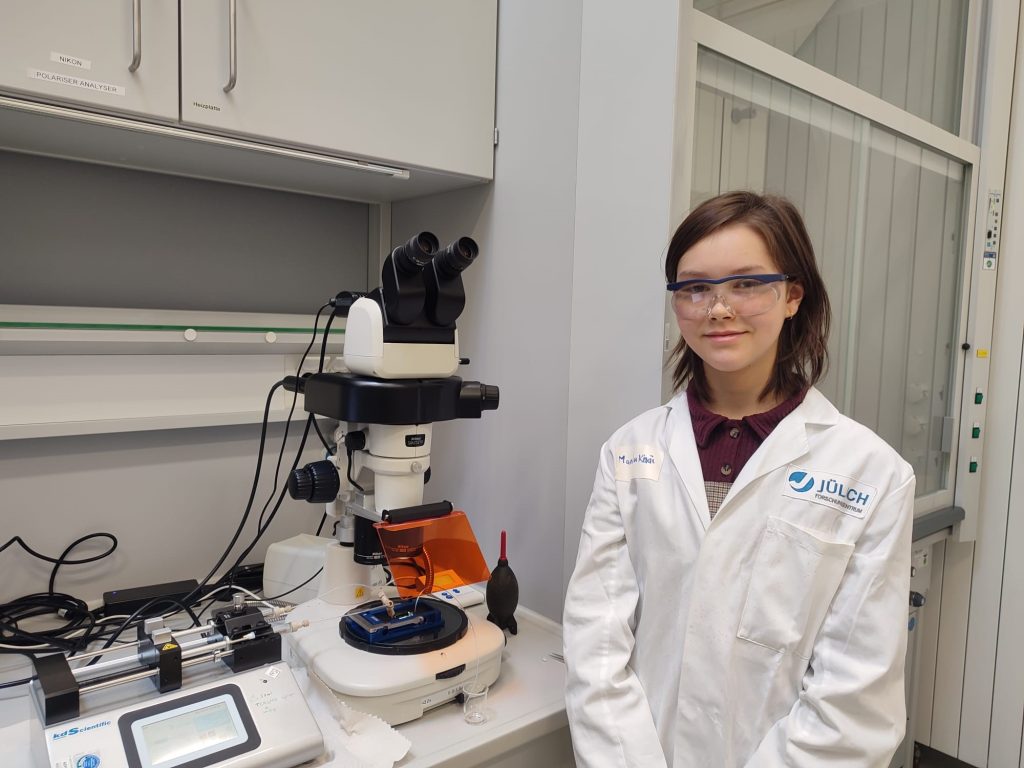In April and October of 2023, Overbach High School student Mandukhai Ritman embarked on a challenging internship at our Institute for Nuclear Waste Management. Her three-week mission aimed at unraveling the mysteries of safe radioactive waste disposal.
Dr. Jenna Poonoosamy’s team welcomed Mandukhai, and together they delved into a project exploring the long-term behavior of nuclear waste. Through a series of experiments, Mandukhai investigated methods for radionuclide co-precipitation. This internship wasn’t just about science; it was a confidence booster for Mandukhai. The research experience ignited a passion for scientific inquiry, and she now sets her sights on a future career in science herself.
My Experience as a Student Intern
von Mandukhai Ritman

Many conflicting opinions on nuclear power and the environment are expressed to me during my classes at the Gymnasium Haus Overbach, at extracurricular events, and in the news. Often, people are very emotional and make strong claims from a distinct political viewpoint, but at the same time, they typically have very little founded knowledge on the matter. Even though few commonly accepted facts are provided, we are expected to form justified opinions on nuclear power when we debate in class or when speaking individually with other interested students. Since I do not know how much of what is said is really true or whom to believe, I wanted to gain first-hand knowledge in order to put myself in a position to develop an informed opinion.
The management and disposal of nuclear waste is an area with lots of uncertainties and challenges, so I wanted to learn more about it. Since we cannot just make the waste disappear, we must first understand what happens in the hundreds of thousands of years that it will need to be stored underground before we are able to come up with good engineering solutions. The list of issues is long and accordingly, identifying suitable locations for a disposal facility takes many years, with Germany predicting at least 30 years. Meanwhile, the waste is stored above ground in bespoke facilities requiring continuous institutional control, safeguarding and security measures. Scientists have been trying to make predictions of what processes will take place underground in the long-term to help settle the debate on a suitable environment for a deep geological repository.
I completed a three-week internship in 2023 with Dr. Jenna Poonoosamy (PhD) at the Institute of Energy and Climate Research – Nuclear Waste Management (IEK-6), FZJ. To begin with Dr. Poonoosamy gave me an overview of her team’s work: developing numerical models to accurately predict the processes that take place underground over hundreds of thousands of years in a nuclear waste repository. With such numerical models, one could determine the safety of repository systems and develop approaches to significantly speed up and improve the search for a location of a disposal facility.
To create a realistic model, one needs to describe the processes involved with well parameterized mathematical equations. Often, such data are not available in literature. For example, the co-precipitation of radium bearing minerals is a highly relevant process as it immobilizes radium (226), which contributes significantly to the radiation doses during the later stages of the nuclear waste repository; yet the growth mechanisms and rates of these minerals are unknown as it is hard to work with these highly radioactive substances. To overcome this difficulty, she uses microfluidics.
My task was to investigate the mixing behavior of fluids in one such microfluidic reactor that would later be used to investigate the crystallization of radium bearing minerals. I was to find the optimal flow conditions to investigate the growth rate of the non-radioactive mineral calcite (calcium carbonate or more commonly known as chalk). Based on my first experiment I optimized the flow conditions and concentrations of the reacting solutions to grow calcium carbonate crystals spaced with sufficient distance from each other so that they could be monitored by a microscopy image analyst. I also simulated the experiment on the computer. Dr. Poonoosamy let me experiment with a computational fluid dynamics software that can simulate the flow of fluids. This method was entirely new to me and really left an impression on me because I realized how much a scientist must learn continuously. The joy of learning even after formal education has finished is one of the things I liked the most.
The internship has exposed me to processes taking place in the subsurface over thousands of years. It has given me confidence that humankind has the tools needed to find a solution to the disposal of radioactive waste, thereby bringing us a step closer to being able to use nuclear power as a safe and environmentally friendly energy source. This experience has also piqued my interest to become a researcher myself. I am grateful to Forschungszentrum Jülich for enabling me to do this internship, and in particular to Dr. Jenna Poonoosamy and her team for their time and engagement in motivating the next generation to learn about and apply the scientific method in order to gain insights into systems that are highly relevant for society.

No Comments
Be the first to start a conversation